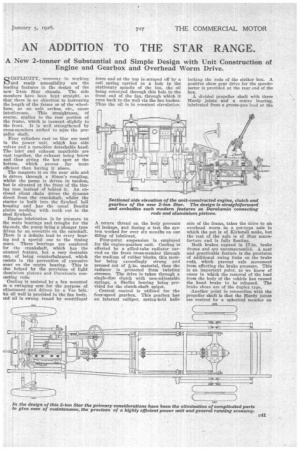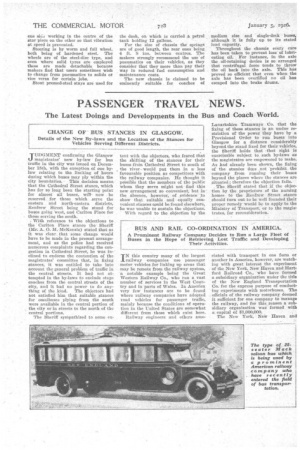AN ADDITION TO THE STAR RANGE.
Page 25

Page 26

If you've noticed an error in this article please click here to report it so we can fix it.
A New 2-tonner of Substantial and Simple Design with Unit Construction of Engine and Gearbox and Overhead Worm Drive.
SIMPLICITY, economy in working and ready accessibility are the leading features in the design of the new 2-ton Star chassis. The side members have been kept straight, so that there is no objection to increasing the length of the frame or of the wheelbase, as no axle arches, etc., cause interference. This straightness, of course, applies to the rear portion of the frame, which is inswept slightly to the front. It is well strengthened by cross-members arched to miss the propeller shaft.
Four cylinders cast en bloc are used in the power unit, which has side valves and a monobloc detachable head. The inlet and exhaust manifolds are cast together, the exhaust being below and thus giving the hot spot at the bottom, which proves far more efficient than having it above.
The magneto is on the near side and is driven through a Simm's coupling, whilst the pump is driven in tandem, but is situated at the front of the timing case instead of behind it. An enclosed silent chain drives the dynamo direct from the crankshaft, whilst the starter is built into the flywheel bell housing and has the usual Bendix pinion meshing with teeth cut in the steel flywheel.
Engine lubrication is by pressure to the main bearings and troughs for the big-ends, the pump being a plunger type driven by an eccentric on the camshaft. There is a definite lead to every bearing and a special one to the timing rears. Three bearings are employed for the crankshaft, which has the unusual feature, but a very desirable one, of being counterbalanced, which assists in the prevention of excessive wear on the centre bearing. This is also helped by the provision of light fluminium pistons and Duralumin conaecting rods.
Cooling is assisted by a fan mounted m a swinging arm for the purpose of tdjustment and driven by a Vee belt. in oil well is provided in the fan body, and oil is swung round by centrifugal force and at the top is scraped off by a coil spring carried in a hole in the stationary spindle of the fan, the oil being conveyed through this hole to the front end of the fan, through which it runs back to the well via the fan bushes. Thus the oil is in constant circulation.
A return thread on the body prevents oil leakage, and during a test the system worked for over six months on one filling of lubricant.
Four-point suspension is employed for the engine-gearbox unit. Cooling is effected by a gilled-tube radiator carried on the front cross-member through the medium of rubber blocks, this member being exceedingly strong and pressed out of torin. material, thus the radiator is protected from twisting stresses. The drive is taken through a single-disc clutch with non-adjustable springs, a Skefko beating being provided for the clutch-shaft spigot.
Central control is utilized for the four-speed gearbox. This gearbox has an internal calliper, spring-held balls locking the rods of the striker box. A positive skew gear drive for the speedometer is provided at the rear end of the box.
A divided propeller shaft with three Hardy joints and a centre bearing, lubricated from a grease-gun lead at the side of the frame, takes the drive to an overhead worm in a pot-type axle in which the pot is of Kirkstall make, but the rest of the axle is of Star manufacture and is fully floating.
Both brakes expand in 17-in, brake drums and are uncompensated. A neat and practicable feature is the provision of additional swing links on the brake rods, which prevent axle movement from affecting the brake pressure. This is an important point, as we know of eases in which the removal of the load from the body of the vehicle has caused the hand brake to be released. The brake shoes are of the duplex type.
Another point in connection with the propeller shaft is that the Hardy joints are centred by a spherical member on one sic"..: working in the centre of the star piece on the other so that vibration at speed is prevented.
• Steering is by worm and full wheel, both being of hardened steel. The wheels are of the steel-disc type, and even where solid tyres are employed these are made detachable because makers find that users sometimes wish to change from pneumatics to solids or vice versa for certain jobs.
Stout pressed-steel stays are used for the dash, on which is carried a petrol tank holding 12 gallons.
For the size of chassis the springs are of good length, the rear ones being 4 ft, 8 ins. between centres. The makers strongly recommend the use of pneumatics on their vehicles, as they consider that they more than pay their way in reduced fuel consumption and maintenance costs.
The new chassis is claimed to be eminently suitable for coaches of medium size and single-deck buses, although it is fully up to its stated load capacity. Throughout the chassis every care has been taken to prevent loss of lubricating oil. For instance, in the axle the oil-retaining device is so arranged that centrifugal force tends to throw the oil back into the axle. This has proved so efficient that even when the axle has been overfilled no oil has escaped into the brake drums.
































